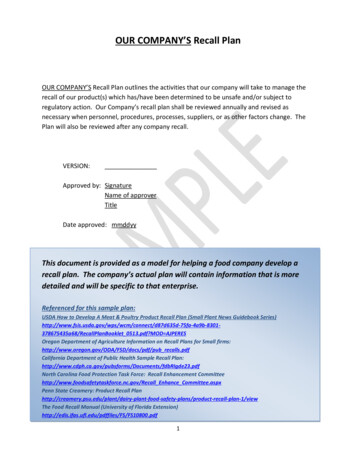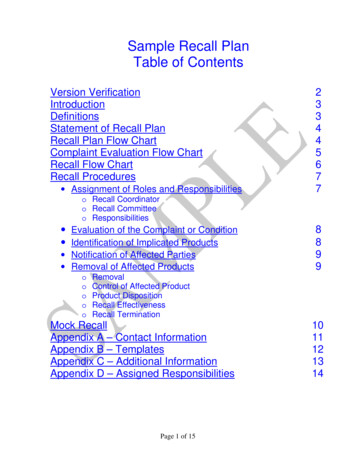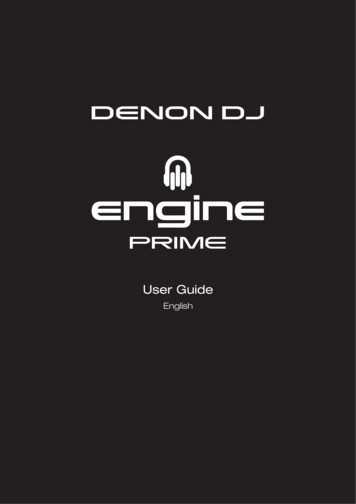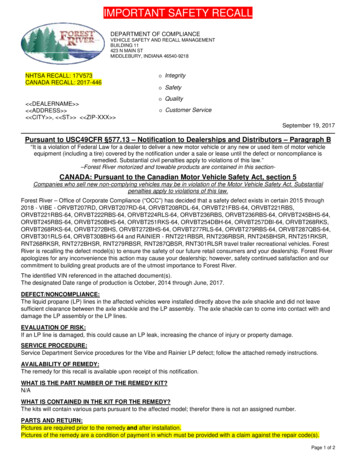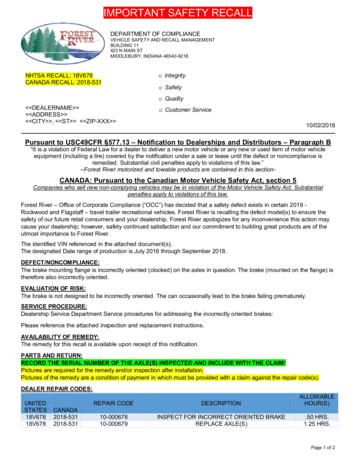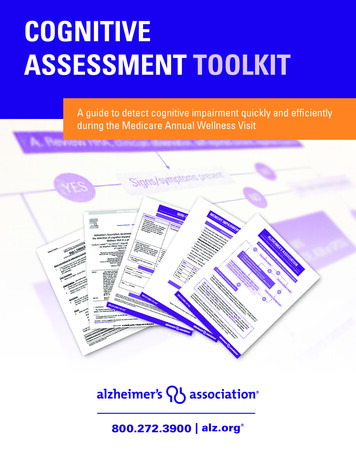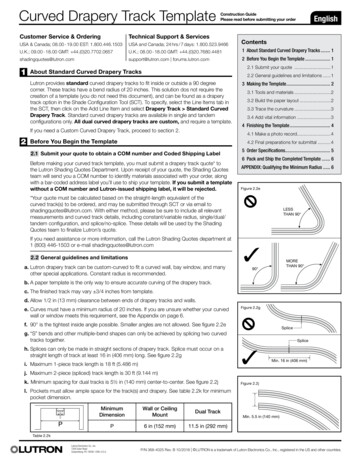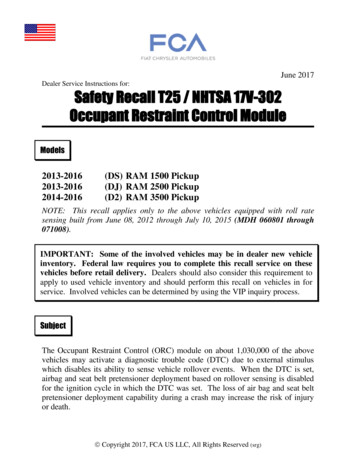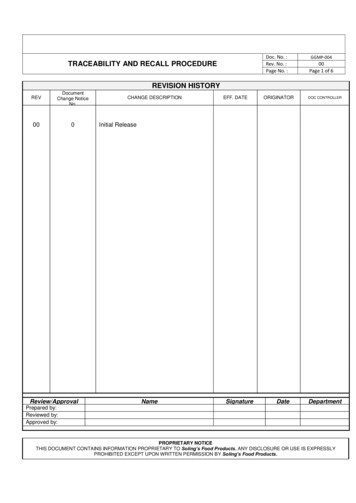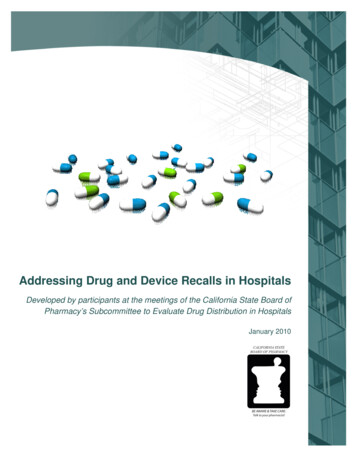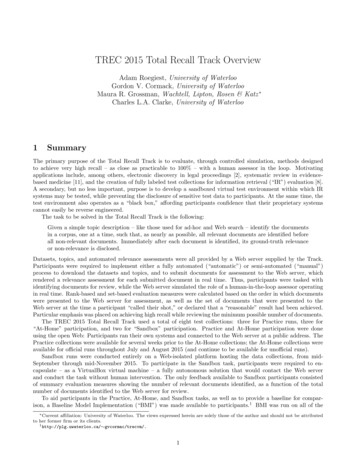
Transcription
TREC 2015 Total Recall Track OverviewAdam Roegiest, University of WaterlooGordon V. Cormack, University of WaterlooMaura R. Grossman, Wachtell, Lipton, Rosen & Katz Charles L.A. Clarke, University of Waterloo1SummaryThe primary purpose of the Total Recall Track is to evaluate, through controlled simulation, methods designedto achieve very high recall – as close as practicable to 100% – with a human assessor in the loop. Motivatingapplications include, among others, electronic discovery in legal proceedings [2], systematic review in evidencebased medicine [11], and the creation of fully labeled test collections for information retrieval (“IR”) evaluation [8].A secondary, but no less important, purpose is to develop a sandboxed virtual test environment within which IRsystems may be tested, while preventing the disclosure of sensitive test data to participants. At the same time, thetest environment also operates as a “black box,” affording participants confidence that their proprietary systemscannot easily be reverse engineered.The task to be solved in the Total Recall Track is the following:Given a simple topic description – like those used for ad-hoc and Web search – identify the documentsin a corpus, one at a time, such that, as nearly as possible, all relevant documents are identified beforeall non-relevant documents. Immediately after each document is identified, its ground-truth relevanceor non-relevance is disclosed.Datasets, topics, and automated relevance assessments were all provided by a Web server supplied by the Track.Participants were required to implement either a fully automated (“automatic”) or semi-automated (“manual”)process to download the datasets and topics, and to submit documents for assessment to the Web server, whichrendered a relevance assessment for each submitted document in real time. Thus, participants were tasked withidentifying documents for review, while the Web server simulated the role of a human-in-the-loop assessor operatingin real time. Rank-based and set-based evaluation measures were calculated based on the order in which documentswere presented to the Web server for assessment, as well as the set of documents that were presented to theWeb server at the time a participant “called their shot,” or declared that a “reasonable” result had been achieved.Particular emphasis was placed on achieving high recall while reviewing the minimum possible number of documents.The TREC 2015 Total Recall Track used a total of eight test collections: three for Practice runs, three for“At-Home” participation, and two for “Sandbox” participation. Practice and At-Home participation were doneusing the open Web: Participants ran their own systems and connected to the Web server at a public address. ThePractice collections were available for several weeks prior to the At-Home collections; the At-Home collections wereavailable for official runs throughout July and August 2015 (and continue to be available for unofficial runs).Sandbox runs were conducted entirely on a Web-isolated platform hosting the data collections, from midSeptember through mid-November 2015. To participate in the Sandbox task, participants were required to encapsulate – as a VirtualBox virtual machine – a fully autonomous solution that would contact the Web serverand conduct the task without human intervention. The only feedback available to Sandbox participants consistedof summary evaluation measures showing the number of relevant documents identified, as a function of the totalnumber of documents identified to the Web server for review.To aid participants in the Practice, At-Home, and Sandbox tasks, as well as to provide a baseline for comparison, a Baseline Model Implementation (“BMI”) was made available to participants.1 BMI was run on all of the Current affiliation: University of Waterloo. The views expressed herein are solely those of the author and should not be attributedto her former firm or its clients.1 http://plg.uwaterloo.ca/ gvcormac/trecvm/.1
collections, and summary results were supplied to participants for their own runs, as well as for the BMI runs.The system architecture for the Track is detailed in a separate Notebook paper titled Total Recall Track ToolsArchitecture Overview [16].The TREC 2015 Total Recall Track attracted 10 participants, including three industrial groups that submitted“manual athome” runs, two academic groups that submitted only “automatic athome” runs, and five academicgroups that submitted both “automatic athome” and “sandbox” runs.The 2015 At-Home collections consisted of three datasets and 30 topics. The Jeb Bush emails2 were collected andassessed for 10 topics by the Track coordinators. The “Illicit Goods” and “Local Politics” datasets, along with 10topics for each, were derived from the Dynamic Domain datasets 3 and assessed by the Total Recall coordinators.These collections continue to be available through the Total Recall Server to 2015 participants, and were madeavailable to 2016 participants for training purposes.The Sandbox collections consisted of two datasets and 23 topics. On-site access to former Governor Tim Kaine’semail collection at the Library of Virginia4 was arranged by the Track coordinators, where a “Sandbox appliance”was used to conduct and evaluate participant runs according to topics that corresponded to archival category labelspreviously applied by the Library’s Senior State Records Archivist: “Not a Public Record,” “Open Public Record,”“Restricted Public Record,” and “Virginia Tech Shooting Record.” The coordinators also secured approval to usethe MIMIC II clinical dataset5 as the second Sandbox dataset. The textual documents from this dataset – consistingof discharge summaries, nurses’ notes, and radiology reports – were used as the corpus; the 19 top-level codes inthe ICD-9 hierarchy6 were used as the “topics.”The principal tool for comparing runs was a gain curve, which plots recall (i.e., the proportion of all relevantdocuments submitted to the Web server for review) as a function of effort (i.e., the total number of documentssubmitted to the Web server for review). A run that achieves higher recall with less effort demonstrates superioreffectiveness, particularly at high recall levels. The traditional recall-precision curve conveys similar information,plotting precision (i.e., the proportion of documents submitted to the Web server that are relevant) as a function ofrecall (i.e., the proportion of all relevant documents submitted to the Web server for review). Both curves conveysimilar information, but are influenced differently by prevalence or richness (i.e., the proportion of documents inthe collection that are relevant), and convey different impressions when averaged over topics with different richness.A gain curve or recall-precision curve is blind to the important consideration of when to stop a retrieval effort.In general, the density of relevant documents diminishes as effort increases, and at some point, the benefit ofidentifying more relevant documents no longer justifies the review effort required to find them. Participants wereasked to “call their shot,” or to indicate when they thought a “reasonable” result had been achieved; that is, tospecify the point at which they would recommend terminating the review process because further effort would be“disproportionate.” They were not actually required to stop at this point, they were simply given the option toindicate, contemporaneously, when they would have chosen to stop had they been required to do so. For this point,we report traditional set-based measures such as recall, precision, and F1 .To evaluate the appropriateness of various possible stopping points, the Track coordinators devised a newparametric measure: recall @ aR b, for various values of a and b. Recall @ aR b is defined to be the recallachieved when aR b documents have been submitted to the Web server, where R is the number of relevantdocuments in the collection. In its simplest form recall @aR b [a 1; b 0] is equivalent to R-precision,which has been used since TREC 1 as an evaluation measure for relevance ranking. R-precision might equally wellbe called R-recall, as precision and recall are, by definition, equal when R documents have been reviewed. Theparameters a and b allow us to explore the recall that might be achieved when a times as many documents, plusan additional b documents are reviewed. The parameter a admits that it may be reasonable to review more thanone document for every relevant one that is found; the parameter b admits that it may be reasonable to review afixed number of additional documents, over and above the number that are relevant. For example, if there are 100relevant documents in the collection, it may be reasonable to review 200 documents (a 2), plus an additional 100documents (b 100), for a total of 300 documents, in order to achieve high recall. In this Track Overview paper,we report all combinations of a {1, 2, 4} and b {0, 100, 1000}.At the time of 2015 Total Recall Track, the coordinators had hoped to be able to implement facet-based variantsof the recall measures described above (see Cormack & Grossman [3]), but suitable relevance assessments for thefacets were not available in time. We therefore decided to implement such measures in a future Track. The rationalefor facet-based measures derives from the fact that, due to a number of factors including assessor disagreement,2 jebemails.com/home.3 http://trec-dd.org/.4 http://www.virginiamemory.com/collections/kaine/.5 https://physionet.org/mimic2/.6 https://en.wikipedia.org/wiki/Listof ICD-9 codes.2
a goal of recall 1.0 is neither reasonable nor achievable in most circumstances. However, it is difficult to justifyan arbitrary lower target of, say, recall 0.8, without characterizing the nature of the 20% relevant documents thatare omitted by such an effort. Are these omitted documents simply marginal documents about whose relevancereasonable people might disagree, or do they represent a unique and important (though perhaps rare) class of clearlyrelevant documents? To explore this question, we wanted to be able to calculate the recall measures for a given runseparately for each of several facets representing different classes of documents; a superior high-recall run shouldbe expected to achieve high recall on all facets. This issue remains to be explored.In calculating effort and precision, the measures outlined above consider only the number of documents submittedto the Web server for assessment. For manual runs, however, participants were permitted to look at the documents,and hence conduct their own assessments. Participants were asked to track and report the number of documentsthey reviewed; when supplied by participants, these numbers are reported in this Overview and should be consideredwhen comparing manual runs to one another, or to automatic runs. It is not obvious how one would incorporatethis effort formulaically into the gain curves, precision-recall curves, and recall @ aR b measures; therefore, thecoordinators have chosen not to try.Results for the TREC 2015 Total Recall Track show that a number of methods achieved results with very highrecall and precision, on all collections, according to the standards set by previous TREC tasks. This observationshould be interpreted in light of the fact that runs were afforded an unprecedented amount of relevance feedback,allowing them to receive authoritative relevance assessments throughout the process.Overall, no run consistently achieved higher recall at lower effort than BMI. A number of runs, including manualruns, automatic runs, and the baseline runs, appeared to achieve similar effectiveness – all near the best on everycollection – but with no run consistently bettering the rest on every collection. Thus, The 2015 Total Recall Trackhad no clear “winner.”2Test CollectionsEach test collection consisted of a corpus of English-language documents, a set of topics, and a complete set ofrelevance assessments for each topic. For Practice runs, we used three public document corpora for which topicsand relevance assessments were available: The 20 Newsgroups Dataset,7 consisting of 18,828 documents from each of 20 newsgroups. We used three ofthe newsgroup subject categories – “space,” “hockey,” and “baseball” – as the three practice topics in the testpractice collection. The Reuters-21578 Test Collection,8 consisting of 21,578 newswire documents. We used four of the subjectcategories – “acquisitions,” “Deutsche Mark,” “groundnut,” and “livestock” – as the four practice topics inthe test practice collection. The Enron Dataset used by the TREC 2009 Legal Track [10]. We used a version of this dataset capturedby the University of Waterloo in the course of its participation in TREC 2009, modified to exclude vacuousdocuments, resulting in a corpus of 723,537 documents. We used two of the topics from the TREC 2009 LegalTrack – “Fantasy Football” and “Prepay Transactions” – as the two practice topics for the bigtest practicecollection. The relevance assessments were derived from those rendered by the University of Waterloo teamand the official TREC assessments, with deference to the official assessments.For the At-Home runs, we used three new datasets: The (redacted) Jeb Bush Emails,9 consisting of 290,099 emails from Jeb Bush’s eight-year tenure as Governorof Florida. We used 10 issues associated with his governorship as topics for the athome1 test collection:“school and preschool funding,” “judicial selection,” “capital punishment,” “manatee protection,” “new medical schools,” “affirmative action,” “Terri Schiavo,” “tort reform,” “Manatee County,” and “Scarlet LetterLaw.” Using the continuous active learning (“CAL”) method of Cormack and Mojdeh [5], the Track coordinators assessed documents in the corpus to identify as many of the relevant documents for each topic asreasonably possible.7 http://qwone.com/ jason/20Newsgroups/.8 ns/reuters21578/.9 jebemails.com/home.3
Participating ooClarkeWaterlooCormackWebisWHU ineMIMIC 1A2ATable 1: Participation in the TREC 2015 Total Recall Track. Table entries indicate the number of runs submittedfor each test collection by a particular participating team. “M” indicates manual runs, “A” indicates automaticruns. The Illicit Goods dataset collected for the TREC 2015 Dynamic Domain Track [17]. We used 465,147 documents collected from Blackhat World10 and Hack Forum.11 For the athome2 test collection, we used 10 of themany topics that were composed and partially assessed by NIST assessors for use by the Dynamic DomainTrack: “paying for Amazon book reviews,” “CAPTCHA services,” “Facebook accounts,” “surely Bitcoins canbe used,” “Paypal accounts,” “using TOR for anonymous browsing,” “rootkits,” “Web scraping,” “articlespinner spinning,” and “offshore Web sites.” The Track coordinators re-assessed the documents using theCAL method of Cormack and Mojdeh [5], to identify as many of the relevant documents for each topic asreasonably possible. The Local Politics dataset collected for the TREC 2015 Dynamic Domain Track [17]. We used 902,434 articlescollected from news sources in the northwestern United States and southwestern Canada. For the athome3test collection, we used 10 of the many topics that were composed and partially assessed by NIST assessorsfor use by the Dynamic Domain Track: “Pickton murders,” “Pacific Gateway,” “traffic enforcement cameras,”“rooster chicken turkey nuisance,” “Occupy Vancouver,” “Rob McKenna gubernatorial candidate,” “Rob FordCut the Waist,” “Kingston Mills lock murder,” “fracking,” and “Paul and Cathy Lee Martin.” The Trackcoordinators re-assessed the documents using the CAL method of Cormack and Mojdeh [5], to identify asmany of the relevant documents for each topic as reasonably possible.For the Sandbox runs, we used two new datasets: The Kaine Email Collection at the Library of Virginia.12 From the 1.3M email messages from Tim Kaine’seight-year tenure as Governor of Virginia, we used 401,953 that had previously been labeled by the VirginiaSenior State Records Archivist according to the following four categories: “public record,” “open record,”“restricted record,” and “Virginia Tech shooting ([subject to a legal] hold).” Each of the four categories wasused as a topic in the kaine test collection. The runs themselves were executed on an isolated computerinstalled at the Library of Virginia and operated by Library of Virginia staff. The MIMIC II Clinical Dataset,13 consisting of anonymized, time-shifted, records for 31,538 patient visits toan Intensive Care Unit. We used the textual record for each patient – consisting of one or more nurses’ notes,radiology reports, and discharge summaries – as a “document” in the corpus, and each of 19 top-level ICD-9codes supplied with the dataset as a topic for the mimic test collection: “infectious and parasitic diseases,”“neoplasms,” “endocrine, nutritional and metabolic diseases, and immunity disorders,” “diseases of the bloodand blood-forming organs,” “mental disorders,” “diseases of the nervous system and sense organs,” “diseasesof the circulatory system,” “diseases of the respiratory system,” “diseases of the digestive system,” “diseasesof the genitourinary system,” “complications of pregnancy, childbirth, and the puerperium,” “diseases of theskin and subcutaneous tissue,” “diseases of the musculoskeletal system and connective tissue,” “congenitalanomalies,” “certain conditions originating in the perinatal period,” “symptoms, signs, and ill-defined conditions,” “injury and poisoning,” “factors influencing health status and contact with health services,” and10 http://www.blackhatworld.com/.11 http://hackforums.net/.12 der-the-hood.13 https://physionet.org/mimic2/.4
“external causes of injury and poisoning.” The runs were executed on an isolated computer installed at theUniversity of Waterloo and operated by the Track coordinators.Table 1 shows the number of runs submitted for each test collection by each participating team.3Participant SubmissionsThe following descriptions are paraphrased from responses to a required questionnaire submitted by each participating team.3.1UvA.ILPSThe UvA.ILPS team [6] used automatic methods for the At-Home and Sandbox tests that modified the BaselineModel Implementation in two ways:1. adjusted the batch size based on the number of retrieved relevant documents and stopped after a threshold ifthe batch contained no relevant documents;2. one run used logistic regression (as per the Baseline Model Implementation), while another used randomforests.3.2WaterlooClarkeThe WaterlooClarke team [9] used automatic methods for At-Home and Sandbox tests that:1. employed clustering to improve the diversity of feedback to the learning algorithm;2. used n-gram features beyond the bag-of-words tf-idf model provided in the Baseline Model Implementation;3. employed query expansion;4. used the fusion of differently ranking algorithms.The WaterlooClarke team consisted of a group of graduate students who had no access to the test collections beyondthat afforded to all participating teams.3.3WaterlooCormackThe WaterlooCormack team [4] employed the Baseline Model Implementation, without modification, except to“call its shot” to determine when to stop. Therefore, the gain curves, recall-precision curves, and recall @ aR bstatistics labeled “WaterlooCormack” are synonymous with the Baseline Model Implementation.Two different stopping criteria were investigated:1. a “knee-detection” algorithm was applied to the gain curve, and the decision that a reasonable result hadbeen achieved was made when the slope of the curve after the knee was a fraction of the slope before the knee;2. a “reasonable” result was deemed to have been achieved when m relevant and n non-relevant documents hadbeen reviewed, where n a · m b , where a and b are predetermined constants. For example, when a 1and b 2399, review would be deemed to be complete when the number of non-relevant documents retrievedwas equal to the number of relevant documents retrieved, plus 2,399. In general, the constant a determineshow many non-relevant documents are to be reviewed in the course of finding each relevant document, whileb represents fixed overhead, independent of the number of relevant documents.The WaterlooCormack team consisted of Gordon V. Cormack and Maura R. Grossman, who were both Trackcoordinators. The Baseline Model Implementation was fixed prior to the development of any of the datasets.Cormack and Grossman had knowledge of the At-Home test collections, but not the Sandbox test collections, whenthe stopping criteria were chosen.5
3.4WebisThe Webis team [15] employed two methods:1. a basic naı̈ve approach in retrieving as many relevant documents as possible;2. a keyphrase experiment that built on the BMI system by intelligently obtaining a list of phrases from documents judged by the API as relevant and using them as new topics for ad-hoc search.3.5CCRiThe CCRi team [7] represented words from the input corpus as vectors using a neural network model and representeddocuments as a tf-idf weighted sum of their word vectors. This model was designed to produce a compact versionsof tf-idf vectors while incorporating information about synonyms. For each query topic, CCRi attached a neuralnetwork classifier to the output of BMI. Each classifier was updated dynamically with respect to the given am [13] employed a manual approach for the athome1, athome2, and athome3 test collections. Eighthours of manual search and review were conducted, on average, per topic. Two of the eight hours were spentcomposing 25 queries (per topic, on average) and examining their results; six hours were spent reviewing 500documents (per topic, on average), of which only those deemed relevant were submitted to the automated assessmentserver. During the search and review process, Web searches were conducted where necessary to inform the searchers.3.7NINJAThe NINJA team employed a manual approach for the athome1, athome2, and athome3 test collections. One hourof manual search was conducted, in which three queries were composed, on average, per topic. Wikipedia andGoogle searches were used to inform the searchers. A commercial “predictive coding” tool, trained using the resultsof the queries, was used to generate the NINJA runs. No documents from the test collection were reviewed priorto being submitted to the automated assessment server.3.8catresThe catres team [12] employed a manual approach for the athome1 test collection. A group of searchers independently spent one hour each investigating each topic, after which a learning tool was used to generate the run.An average of eight manual queries were used per topic, and an average of 262 documents were reviewed. Everydocument reviewed by the team was also submitted to the automated assessment server.3.9TUWThe TUW team [14] applied six variants on the Baseline Model Implementation to all of the At-Home and Sandboxtest collections. The variants included the use and non-use of a BM25 ranking, the use and non-use of stop words,and the use and non-use of tf-idf weighting.3.10WHU IRGroupThe WHU IRGroup team [1] applied iterative query expansion to the athome1 test collection.44.1ResultsGain Curves and Recall-Precision CurvesFigure 1 plots the effectiveness of the best run for each of the participating teams on the athome1 test collection.The top panel plots effectiveness as a gain curve, while the bottom panel plots effectiveness as a recall-precisioncurve. The gain curve shows that a number of the systems achieved 90% recall, on average, with a review effort of10,000 documents. The recall-precision curve, on the other hand, shows that a number of the systems achieved 90%6
Athome1 Dataset -- Recall vs. esTUWWHU 000Athome1 Dataset -- Precision vs. HU IRGroup0.2000.20.40.60.81RecallFigure 1: Athome1 Results – Average Gain and Interpolated Recall-Precision Curves.7
Athome2 Dataset -- Recall vs. .20.10050001000015000Effort200002500030000Athome2 Dataset -- Precision vs. 40.60.81RecallFigure 2: Athome2 Results – Average Gain and Interpolated Recall-Precision Curves.8
Athome3 Dataset -- Recall vs. .20.10050001000015000Effort200002500030000Athome3 Dataset -- Precision vs. 40.60.81RecallFigure 3: Athome3 Results – Average Gain and Interpolated Recall-Precision Curves.9
Kaine Dataset -- Recall vs. 0Effort80000100000120000Kaine Dataset -- Precision vs. ooCormackWebisTUW0.40.2000.20.40.60.81RecallFigure 4: Kaine Results – Average Gain and Interpolated Recall-Precision Curves.10
MIMIC Dataset -- Recall vs. 0Effort200002500030000MIMIC 2 Dataset -- Precision vs. UW0.8Precision0.60.40.2000.20.40.60.81RecallFigure 5: MIMIC II Results – Average Gain and Interpolated Recall-Precision Curves.11
Topic athome100 Athome1 Dataset -- Recall vs. EffortTopic athome101 Athome1 Dataset -- Recall vs. ckWebisCCRieDiscoveryTeamNINJAcatresTUWWHU IRGroup0.2000500010000Effort15000200000Topic athome102 Athome1 Dataset -- Recall vs. Effort500010000Effort1500020000Topic athome103 Athome1 Dataset -- Recall vs. NJAcatresTUWWHU isCCRieDiscoveryTeamNINJAcatresTUWWHU IRGroup0.2000500010000Effort15000200000Topic athome104 Athome1 Dataset -- Recall vs. Effort500010000Effort1500020000Topic athome105 Athome1 Dataset -- Recall vs. ckWebisCCRieDiscoveryTeamNINJAcatresTUWWHU IRGroup0.2000500010000Effort15000200000Topic athome106 Athome1 Dataset -- Recall vs. Effort500010000Effort1500020000Topic athome107 Athome1 Dataset -- Recall vs. NJAcatresTUWWHU isCCRieDiscoveryTeamNINJAcatresTUWWHU 00020000EffortTopic athome108 Athome1 Dataset -- Recall vs. EffortTopic athome109 Athome1 Dataset -- Recall vs. NJAcatresTUWWHU 500020000Effort050001000015000EffortFigure 6: Per-Topic Gain Curves for the Athome1 Test Collection.1220000
Topic athome2052 Athome2 Dataset -- Recall vs. EffortTopic athome2108 Athome2 Dataset -- Recall vs. 000Topic athome2129 Athome2 Dataset -- Recall vs. Effort500010000Effort1500020000Topic athome2130 Athome2 Dataset -- Recall vs. 000Topic athome2134 Athome2 Dataset -- Recall vs. Effort500010000Effort1500020000Topic athome2158 Athome2 Dataset -- Recall vs. 000Topic athome2225 Athome2 Dataset -- Recall vs. Effort500010000Effort1500020000Topic athome2322 Athome2 Dataset -- Recall vs. 0Effort100001500020000EffortTopic athome2333 Athome2 Dataset -- Recall vs. EffortTopic athome2461 Athome2 Dataset -- Recall vs. rt050001000015000EffortFigure 7: Per-Topic Gain Curves for the Athome2 Test Collection.1320000
Topic athome3089 Athome3 Dataset -- Recall vs. EffortTopic athome3133 Athome3 Dataset -- Recall vs. Effort0.80.80.60.6Recall1Recall10.40.4UvA.ILP
The TREC 2015 Total Recall Track used a total of eight test collections: three for Practice runs, three for \At-Home" participation, and two for \Sandbox" participation. Practice and At-Home participation were done using the open Web: Participants ran their own systems and connected to
